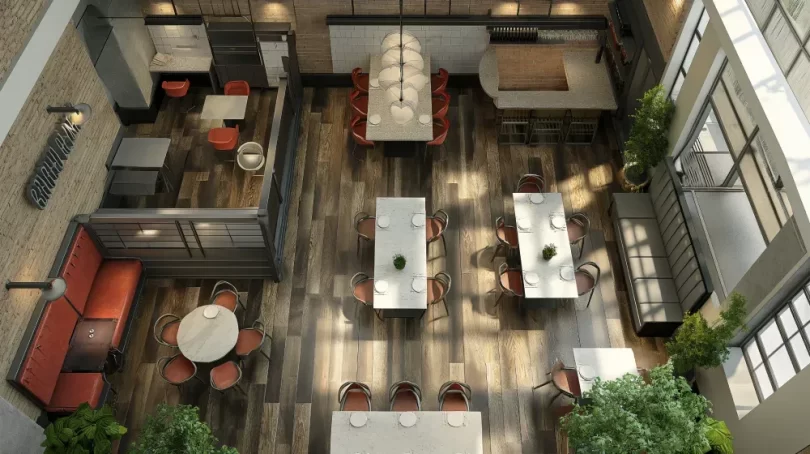Running a restaurant in a hot climate comes with its own challenges, and cooling the dining area is one of the biggest. When table placement is done without considering airflow, comfort suffers, and air conditioning costs climb. Guests seated in warmer spots often leave sooner, order less, and are less likely to return. On the other hand, a well‑planned layout can make a noticeable difference in both comfort and energy bills.
In many warm‑weather markets, cooling can account for 25 to 40 percent of total utility expenses. When tables are clustered near warm zones such as kitchen doors or sunny windows, air circulation becomes uneven. This forces your cooling system to work harder than it needs to, raising operating costs. Borrowing planning techniques from air conditioning installation, like load calculations and zoning, can guide restaurant owners in creating layouts that feel better for guests and cost less to run. Some restaurants have even cut cooling loads by 10 to 15 percent simply by rethinking where restaurant tables go.
Table placement is more than just filling the floor with chairs. It is a strategic move that shapes how customers experience your space while protecting your bottom line. By treating it as part of your cooling strategy, you can balance comfort, efficiency, and profitability.
Contents
- 1 How Heat Behaves Inside a Dining Room
- 2 What AC Installation Can Teach About Seating Layouts
- 3 Placing Tables for the Best Cooling
- 4 Using Shade and Natural Air to Your Advantage
- 5 Cutting Cooling Costs with Smarter Layouts
- 6 Keeping Comfort Consistent Over Time
- 7 Finding the Sweet Spot Between Comfort and Cost
How Heat Behaves Inside a Dining Room
Not all tables feel the same to guests. Solar gain is a big factor, and tables near glass walls or doors can heat 15 percent more quickly during sunny hours. Hot spots are also common near the kitchen, refrigeration exhausts, or in corners with poor ventilation.
Ceiling height changes the game. In rooms with ceilings 12 feet or higher, cooler air tends to settle lower, leaving wall‑side tables warmer. Booth clusters can block airflow so much that circulation drops by half. Even the shape of the tables matters, as round and rectangular tables interact differently with air movement.
Your space may also have “micro‑climates.” These are small areas where the temperature feels different due to shading, air movement, or heat reflection from surfaces. Poor airflow can raise temperatures by 1 to 2 degrees Celsius above the rest of the room. Knowing where these zones form helps you choose the best seating positions.
What AC Installation Can Teach About Seating Layouts
When HVAC professionals install cooling systems, they calculate carefully where the equipment should go and how powerful it should be. They factor in kitchen heat, ceiling height, glass surfaces, and airflow patterns. The same approach works for seating.
Installing AC in a 3,000 to 4,000 square‑foot restaurant often costs between $9,000 and $16,000, or about $3 to $6 per square foot. Costs depend heavily on duct length, airflow balancing, and where units are placed. This is similar to how table positioning affects how well cool air reaches guests.
Just as HVAC experts may use multiple smaller units instead of one oversized system, restaurants can benefit from dividing their dining area into zones. Some areas may need fewer seats to stay comfortable. Maintenance is important too. Clean coils and filters keep air moving efficiently, just as occasional layout checks make sure tables stay in airflow paths.
Placing Tables for the Best Cooling
Finding the right spots for tables means thinking about where cool air enters the room and where heat builds up. Large party tables are best placed in steady, evenly cooled areas rather than directly under vents or next to hot zones.
Seats placed under vents can cause discomfort from drafts and uneven temperatures. Tables near kitchen doors should be tested to make sure they are not affected by heat during busy hours. Low partitions can help direct airflow into seating areas, while ceiling fans can circulate cool air without creating unpleasant gusts.
Spacing tables at least 1.2 meters apart allows air to move freely and reduces heat build‑up from crowded seating. Trial runs in different dining areas help identify hot and cold boundaries. Entryways can work in your favor if designed well, letting in cooler bursts of outside air that mix with conditioned air.
Using Shade and Natural Air to Your Advantage
Outdoor comfort can take pressure off indoor cooling. Shaded patios or verandas can reduce the need for indoor seating by up to 20 percent during peak heat. Planting trees or adding awnings can lower heat from sunlight by 30 to 50 percent, especially on sun‑facing windows.
Thermal blinds or window films can block up to 70 percent of heat‑carrying infrared radiation. Operable vents or high windows can release trapped warm air and invite breezes inside. Even the angle of tables matters, with a 30‑degree alignment to the prevailing breeze helping circulate air naturally.
Pergolas with heat‑reflective covers create cooler seating zones, and opening kitchen pass‑through windows in cooler hours can act like a natural exhaust system. Combining these natural methods with mechanical cooling can improve system efficiency by 15 to 25 percent.
Cutting Cooling Costs with Smarter Layouts
Moving just a few tables away from warmer areas can reduce cooling system runtime by 5 to 10 percent. Seating density plays a role too, as tight clusters increase body heat while wide spacing can cut revenue.
Open corridors help air move evenly. Flexible furniture arrangements allow the space to adapt to seasonal needs. Some restaurants have lowered cooling energy use by up to 18 percent with smart layouts during the hottest months.
Savings from lower cooling costs can go toward guest comfort upgrades such as misting fans for patios. Wireless temperature sensors can track hot spots and guide adjustments. A layout survey often costs less than 1 percent of annual utility spend, yet can bring long‑term returns.
Keeping Comfort Consistent Over Time
Good layouts are not permanent. Seasonal seating audits can reveal new issues caused by shifting sun angles or guest patterns. Low‑cost temperature loggers can track how heat changes in different areas over time.
If one zone forces the AC to cycle more often, moving a few tables can ease the load. Staff should be trained to notice when guests ask to change seats. A simple tagging system helps identify problem tables.
Energy bills can also guide adjustments. Monthly comparisons may show patterns that call for seating changes. Annual airflow balancing and filter cleaning before the hot season can boost airflow by up to 15 percent, making it easier to keep all seats comfortable.
Finding the Sweet Spot Between Comfort and Cost
Well‑planned table placement is more than a design choice. It is a way to keep guests comfortable, cut energy bills, and improve overall restaurant performance. Areas near heat sources, crowded seating, or blocked air paths push your AC into overdrive.
Layouts designed with airflow in mind keep guests seated longer and returning more often. This means both lower cooling costs and higher customer satisfaction.
Optimizing table placement can deliver double‑digit savings with little disruption. When seating is part of your cooling plan, your dining room works as a complete system where every element contributes. This mindset turns your layout into a tool for comfort, loyalty, and profit.







